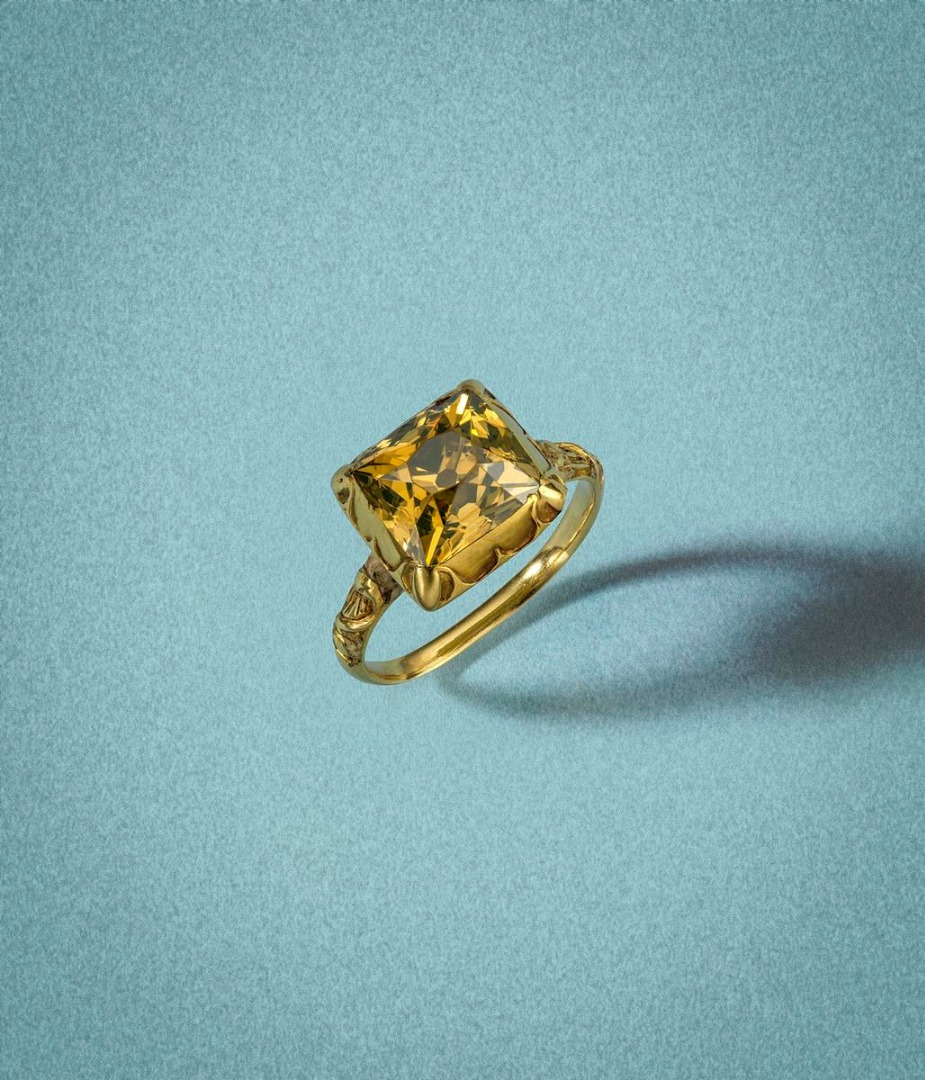Fine Jewellery - 27th October 2016
Lot 1770
A rare yellow diamond
Estimate £20,000 - £30,000 | Hammer £180000
+ Buyers Premium
Description

A rare yellow diamond, enamel and yellow gold ring, last quarter 17th century
The cushion-shaped old brilliant-cut yellow diamond weighs 3.16 carats and is set within the raised box bezel with engrailed edges above arcading filled with stylised acanthus enamelled white with black details, each shoulder chased with an auricular scroll, formerly enamelled, to the plain hoop, the interior of the plain closed back setting lined with black pitch to heighten the golden tint of the stone. Probably English.
Accompanied by report number 2175692368 dated 21st June 2016 from GIA, New York stating that the round-cornered square modified brilliant cut diamond weighs 3.16cts, is a natural, even fancy deep brownish yellow colour with SI2 clarity with strong yellow fluorescence.
COMMENTARY BY DIANA SCARISBRICK
This fine and rare ring set with a brilliant-cut diamond marks a milestone in gemmological history, resulting from the discovery of the laws of refraction and analytical geometry during the second half of the seventeenth century.
Until 1664, when the earliest brilliant-cut diamond, the Wittelsbach, is recorded, diamonds were cut as either point, table or rose-cuts¹. This new multi-faceted technique of cutting released so much more fire and light that Robert de Berquen, in Les Merveilles des Indes Orientales (Paris 1669), compared it with "the sun, shining out amongst all other stones". At the same time, the supply of Golconda diamonds from India increased substantially, encouraged principally by the desire of Louis XIV to make his court at Versailles the most splendid in Europe. Across the Channel, by 1695, London had emerged as the centre of the European trade in diamonds due to the gemmological and financial skills of the resident Portuguese Jewish experts. In addition, as far as cutting and polishing were concerned, although the Dutch lapidaries excelled at rose-cut diamonds, the London workshops were acknowledged as the masters of the new brilliant-cut. It is highly significant that the 410 carat Pitt Diamond acquired by the Regent of France was brilliant-cut by Joseph Cope in London 1704-1706. This superiority is confirmed by the auction catalogue of the precious stones of the Chevalier de la Rocque (1745): "celle de l'Angleterre est plus regulière, plus nette et plus vive: et par consequént plus estimée" (English cutting is more regular, more precise and more lively and therefore of higher value)². These words could equally well be applied to this impeccable ring with its wonderful play of light. During this period, before the discovery of the mines in Brazil in 1727, stones of this size were rare and as in most cases jewellers had to make the best of small stones grouped together in clusters, the survival of a solitaire is exceptional.
Not only is the faceting apparently English, but also the setting, which differs from late 17th century French mounts which are more elaborately decorated and richly enamelled³. Furthermore, the simplified design in this example accords with the change of fashion, marking the turn of the century towards minimally enamelled and less massive settings; thus, not detracting from the splendour of the gem but showing it off to best advantage. Since grander social events were now taking place at night due to improvement in candle lighting, the effect of this diamond displayed on the finger of a high ranking lady or gentleman would have been extraordinary, eclipsing all other stones.
© DIANA SCARISBRICK: August 2016
1. Tillander, H., Diamond Cuts in Historic Jewellery , 1995 p.155
2. Gersaint, E. F., Catalogue Raisonné des differens effets curieux et rare contenus dans le cabinet de feu M. le Chevalier de la Roque , Paris 1745
3. Scarisbrick, D., Rings, Symbols of Wealth, Power and Affection, 1993, pp.92-93, and p.98
DIANA SCARISBRICK, MA, FSA
Diana Scarisbrick is a world-renowned art historian specializing in the history of jewellery and engraved gems. Her extensive research covers jewels from the Renaissance to the present day and she has contributed to numerous exhibitions, catalogues and art journals worldwide.
She is Research Associate at the Beazley Archive, Institute for Classical and Byzantine Studies, Oxford University, and was elected Fellow of the Society of Antiquaries in 1987.